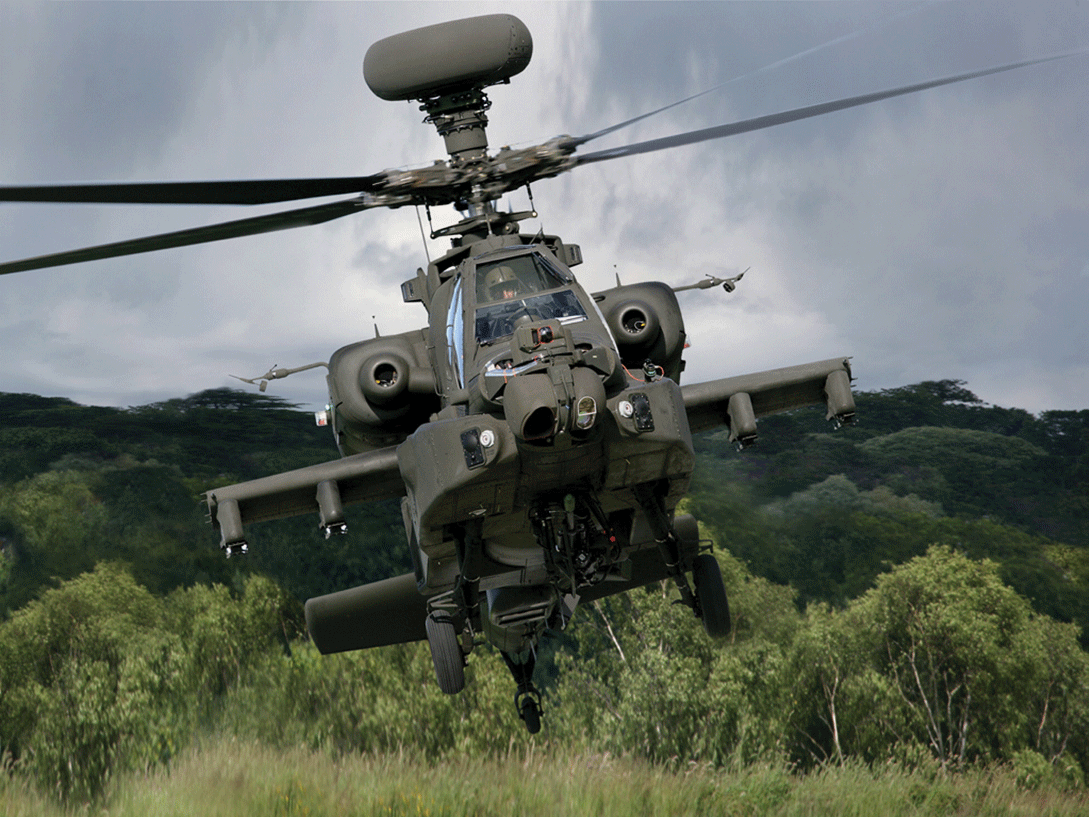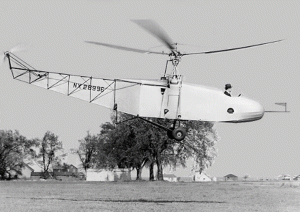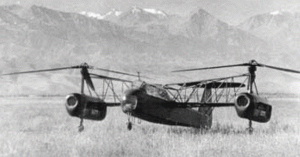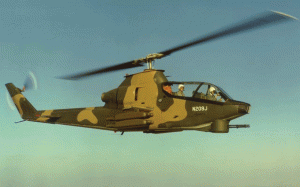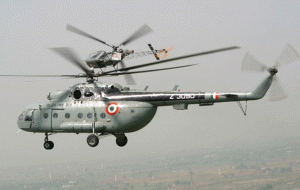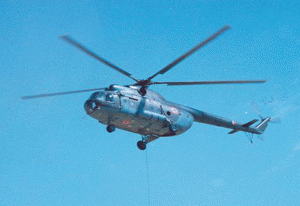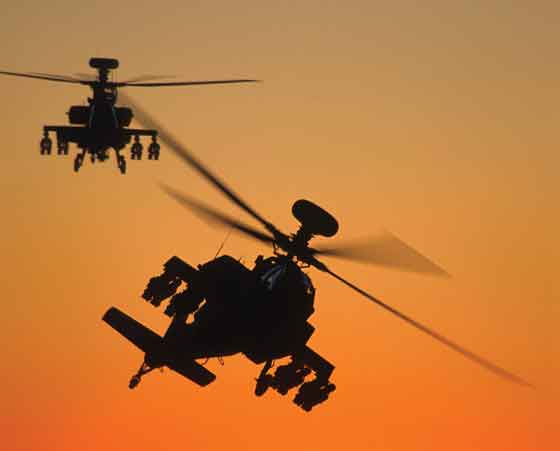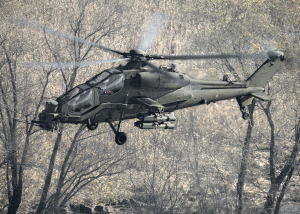Development of the pure helicopter remained painstakingly slow. The first closed circuit kilometre was flown by a helicopter only in 1924, more than 16 years after the first rotary wing flight. Its speed was only eight kmph, three times slower than Roger Bannister’s four-minute-mile! Equally dismally, the world altitude record for a helicopter in 1930, 23 years after the first flight, was only 18 metres! By the mid-1930s, development began to accelerate. The Germans produced a jet helicopter in 1942 built by Friedrich von Doblhoff but it was never mass produced and its prototype was captured by US forces at the end of World War II. The Germans were undoubtedly the pioneers in perceiving the helicopter as a combat platform, but the War took its toll on German helicopter development efforts and prevented large scale development of any type.
The trench warfare stalemate on the western front during World War I led to the debate in the 1930s on the role of the tank, eventually leading to mechanised forces assuming the role of the cavalry. By World War II, the prerogative of manoeuvre was restored to the commander in the field. However, the debate over the battlefield role of the military helicopter initiated at about the same time, persisted well into the 1980s and indeed, continues to engage military thinkers even today.
By World War II, the prerogative of manoeuvre was restored to the commander in the field…
In order to relive the evolution of the helicopter as a combat platform and look into the future, we must fast forward our way through the oft-cited artistic creations of Leonardo da Vinci in 1483, the first rotary wing model of Russian Mikhail Lomonosov’s model that actually flew in 1754, Frenchmen Louis and Jacques Breguet’s flying machine that was the first to lift itself and a pilot off the ground in 1907, Spaniard Juan de la Cierva’s autogyro in 1923, Spanish-born Pescara’s counter-rotating blade helicopter in 1925 to Russia-born American Igor Sikorsky’s first practical helicopter which flew on May 13, 1940. All these inventors deserve a place in history alongside the Wright brothers. Helicopters have evolved and co-existed with fixed-wing platforms. While rotary wing has remained a sub-set of the larger picture, its evolution has established its own paradigms as it evolved, matching the developments in fixed-wing aviation at some planes, intersecting at others, occasionally existing unencumbered.
The Formative Years
Breguet’s primitive helicopter, the first to lift a man off the ground in 1907, lagged behind a similar event by a fixed wing aircraft four years earlier. The problem of countering the rotor torque, however, remained unresolved. This was later solved by introduction of the tail rotor and the first machine to do so was introduced by Boris Yuriev in 1912.
Unfortunately, his machine never got off the ground. World War I was significant to this narrative due to two helicopters, the PKZ-1 and PKZ-2. The PKZ-1 was electric powered and on one of its test flights, carried three men aloft to a height of 20 feet in tethered flight. The PKZ-2 was unique as it had an observer’s cockpit above its rotors that were contra-rotating. On one of the test flights, it remained aloft for half an hour. The early 1920s saw Cierva’s autogyro, a fixed wing aeroplane with a wind milling rotor. Although it could not take off vertically or hover, it represented a major advancement in rotary wing design. Cierva never designed a pure helicopter yet he has a place in history as he was the first to solve the problem associated with unequal lift on different blades of a rotor system by incorporating “flapping” and “dragging” which permit individual blades to flap above or below their mean position in a rotor disc as also to lead or lag behind their nominal position on the disc. One of Cierva’s machines was the first to cross the English Channel. His designs were built in Britain, France, Germany and the US. The C-30 autogyro was used for limited military purposes from 1935 onwards.
Development of the pure helicopter remained painstakingly slow. The first closed circuit kilometre was flown by a helicopter only in 1924, more than 16 years after the first rotary wing flight. Its speed was only eight kmph, three times slower than Roger Bannister’s four-minute-mile! Equally dismally, the world altitude record for a helicopter in 1930, 23 years after the first flight, was only 18 metres! By the mid-1930s, development began to accelerate. Breguet rejuvenated helicopter development in 1936 with his innovation of co-axial contra-rotating rotors. Focke Wolfe of Germany produced the FW-61, a helicopter with a hinged rotor system that broke all existing records in 1937. In 1939, the Germans developed the F-1282 Kolibri, which first flew with the German Navy in 1941 for anti-submarine patrolling. Some aver that the Kolibri was the first military helicopter in the world. The Germans also produced a jet helicopter in 1942 built by Friedrich von Doblhoff but it was never mass produced and its prototype was captured by US forces at the end of World War II. The Germans were undoubtedly the pioneers in perceiving the helicopter as a combat platform, but the War took its toll on German helicopter development efforts and prevented large scale development of any type.
Helicopters have evolved and co-existed with fixed-wing platforms.
Igor Sikorsky, a Russian émigré, has the credit for designing the first military helicopter to enter series production. He is said to have built his first helicopter in Russia in 1909 although the design failed. After fleeing Russia during the Bolshevik Revolution, he established the Sikorsky Aero Engineering Corporation in the US and produced the VS-300 in 1939 and the R-4 in 1942, of which 130 were produced and used for Search And Rescue (SAR). Apart from being a pioneer in designing helicopters, he was also the main force behind the establishment of the helicopter industry in the US.
Back in the USSR, helicopter development progressed in isolation from the rest of the world. There were three trends in development of helicopters; a single engine machine with two contra-rotating rotors on twin booms, one on each side of the fuselage; a large eight-engine, eight-rotor combat design and a single rotor design with two dual propellers mounted on the nose and tail to neutralise torque. According to one account, during 1932, the TsAGI-1-EA flew up to an altitude of 605 metres. Although this beat the official world record of 18 metres, this news was kept from the world due to the Soviet preoccupation with secrecy. Inspired by Cierva, Soviet engineers produced the KASKR-1, TsAGI 2-E, A4, A6, A7, A8, A9, A10, A13, A14 and A15 before World War II. These autogyros had limited success but the A8 deserves special mention because its rotor was designed to tilt so that the autogyro could be steered in flight independent of the direction in which the fuselage was pointing. During the 1930s a wave of arrests affected leading pioneers in the Soviet helicopter design field and progress became stunted. The 1940s saw the advent of the 2MG Omega, the world’s first twin-engine helicopter. Two improved prototypes, the G2 Omega II and G3 Omega III were also produced but establishment apathy and indecisiveness led to their fading into history.
The period ending with World War II is perhaps notable for Sikorsky’s V-300 design, a single rotor system with flapping and dragging hinges, producing varying amounts of lift controlled by altering the angle of attack collectively on all rotor blades. The whole rotor system could be tilted forward, rearward or sideways. A small tail rotor was provided to counter torque forces as well to serve as a rudder for directional control. Produced in 1941, it still remains the most widely used helicopter design in the world especially for those employed in combat roles.
Post World War II
In the 1940s, helicopters were fragile, vulnerable to ground fire, expensive to operate, carried much less load than fixed-wing aircraft for same fuel consumption, had complicated rotor designs, and were not developed as much as fixed-wing aircraft. Civilian interest was thus negligible. Military attention, with a different cost-benefit paradigm, was however won over by the helicopter as a result of the War. Technology improvements provided the necessary impetus to design, while historical events clamoured for a military machine with the attributes of the helicopter.
The 1940s saw the advent of the 2MG Omega, the world’s first twin-engine helicopter.
Unlike other military platforms, the helicopter was first used on the battlefield not in offensive roles but for casualty evacuation. The War in Indochina was perhaps the first such demonstration of the helicopter. The French used the Hiller-360 for medical evacuation and observation while the WS-51 Dragonfly and the WS-55 Whirlwind were used for troop and cargo transportation. The British also made extensive use of these two types during the campaign in Malaya beginning late 1940s and continuing through the 1950s. The British experience with the helicopter in counter-insurgency roles led to their using the helicopter during a two-year operation in Cyprus (late 1950s), Brunei (1962), for three years against Indonesian infiltrators in Malaysia (1963 onwards), and culminated in Northern Ireland when it became a hotbed of insurgency.
The Korean War of the 1950s provided the opportunity and experience to the US military in the employment of helicopters. Old roles were refined and new ones formulated. The Bell H13 Sioux was used for medical evacuation and observation while the Sikorsky H19 was used for medical evacuation, liaison and troop transportation. General Mathew Ridgway, the UN Force Commander, asked for four transport helicopter battalions in 1951. The large-scale deployment of helicopters in Korea underscored the potential of the helicopter for assault operations in addition to medical evacuation and logistics. During the Suez Operation, when a commando assault was launched on November 06, 1956 on Port Said, the British moved 415 men and 25 tonnes of stores ashore from two British carriers in an hour and a half using 16 Whirlwind and six Sycamore helicopters, a classic illustration of the helicopter providing the field commander with the dominance of manoeuvre.
While the roles of the helicopter were being refined on the battlefield, technology continued to empower the rotary wing machine. The first turbine powered helicopter design flew in 1951 while the first such production helicopter, the French Alouette II, appeared in 1955. It is still used by the military all over the world including the Indian Armed Forces. Materials used in construction became lighter and cheaper, engine size and weight reduced and transmission design problems became less difficult to surmount. As design developed and power-to-weight ratios increased, military thinking intuitively found attractive the idea of arming the helicopters to empower the field commander with firepower in the third dimension to assist his manoeuvre. The Navy had similar thoughts too. Indeed, some military historians credit the US Navy with the first attempts to weaponise a helicopter. In an experimental flight in November 1950, 0.30 and 0.50 calibre machine guns were fitted on to jury-rigged swivel gun mounts replacing the doors on a Sikorsky HO3S-1. The recoil of the gun nearly tore off the sides of the fuselage but the ingenuity of the idea set the path for evolution of the helicopter as a combat platform. In the naval context, the helicopter was and is being used in Anti-Submarine Warfare, Anti-Surface Warfare, Over-The-Horizon targeting by ship-borne weapon systems, Airborne Early Warning, Tactical and Logistic support.
The French made extensive use of helicopters in Algeria beginning 1954, arming them with machine guns, rocket pods and air-to-ground missiles. By ceasefire in 1962, the French had over 600 helicopters operating in transportation, evacuation, recce and fire support roles in Algeria. During the late 1950s, the US Army realised the advantage of using helicopters for battlefield recce and observation over fixed wing aircraft. It issued a Light Observation Helicopter (LOH) requirement to replace Bell H13 and Hiller H23. The Hughes OH6 Cayuse Light Utility Helicopter which entered service in September 1966, went on to become “the most popular helicopter of the Vietnam War”. However, rising costs of production led to rejuvenation of the LOH competition in 1967, the end of OH6 production in 1970 and its replacement by Bell OH- 58A Kiowa.
Unlike other military platforms, the helicopter was first used on the battlefield not in offensive roles but for casualty evacuation…
The 1950s and 1960s produced several significant types of helicopters. Apart from the French Alouette II, which was the first turbine powered helicopter introduced in 1955, others that followed were the British Westland Wasp/Scout was one of the best designs produced by the British helicopter industry (1958), Kaman K600, the first US helicopter to have a twin turbo-shaft design (1958), Soviet Mi-8 (a turbine engine evolution of the Mi-41961) whose variants, especially the Mi-17 series, continue to provide excellent service even today.
The Vietnam War has a significant place in the history of military helicopters. The battlefield was ideally suited to the attributes of the helicopter and so was the war scenario. Initially, helicopters were used for combat SAR (HH43Bs operating from Thailand). Later, HH34F detachments were mounted in South Vietnam. In 1965, CH3Cs arrived in Thailand. With a range of 800 kms, these could penetrate deep into North Vietnam. The same year, the CH3C demonstrated in-flight refuelling from a Marine Corps KC135 F tanker and, by 1967, this was routine for combat SAR missions.
Vietnam brought out the need for an armed helicopter to escort other helicopters carrying troops and equipment, and to provide fire support to forces after landing in the battle zone. In 1962, the US Army’s Howze Board (an extensive study of the US Army’s aviation requirements led by Lt Gen Hamilton H Howze) concluded in its report that “Adoption of the airmobile concept is necessary and desirable. In some respects, the transition is inevitable, just as was that from animal mobility to motor.” Thus the 1st Air Cavalry Division (Airmobile) was formed. After prolonged delays and business machinations, Bell Model 209 won the contract for the Advanced Aerial Fire Support System for the Airmobile helicopters. Bell-209 first flew as the AH1 Cobra in October 1966 and its first production model rolled out in 1967. It deserves a special mention in the annals of military helicopter evolution in as much as it was termed as a “gunship” and marked that point in the history of the helicopter at which design moved away from the generalised use as an airborne platform to becoming a specialised task-oriented combat platform.
The arrival of the AH1 Cobra in Vietnam was a notable event. With the capability to carry guns, grenade launchers, rockets and missiles, it proved to be very effective in reducing the vulnerability of helicopters it was escorting during the landing phase while inducting troops into battle. Hits on helicopters dropped from 0.011 per flying hour to 0.0074 for the escorted helicopters. One of the notable successes of helicopters in Vietnam was the evacuation of 1479 personnel by nine helicopters from Saigon on April 29, 1975, during Operation Frequent Wind.
The Korean War of the 1950s provided the opportunity and experience to the US military in the employment of helicopters…
Troop and cargo transportation became an important role for helicopters. During this period there was notable development of heavy lift helicopters in the USSR. While the rest of the world was focussed on light and medium helicopters optimised for battlefield and sea-faring roles, Soviets addressed heavy lift too. The Mi-6, which first flew in 1957, could carry more than 20 tonnes of load and was the world’s largest helicopter then. In the 1960s, this type evolved into the Mi-10 which could carry 15 tonnes externally. The Sikorsky CH-54 Tarhe and the French Aerospatiale SA321 Super Frelon also flew in the 1960s but the Soviet Mi-26, which first flew in 1977, is still the world’s largest helicopter today with a payload of 20 tonnes. A mention must be made of the Soviet Mil V12 which was an unusual test vehicle with two rotors mounted side by side at the ends of a large wing; the distance from one rotor disc to the other was 220 feet, larger than the wing span of a Boeing 747. It could carry a whopping 40.205 tonnes and, although it never went into production, it still holds the world record for payload.
Post Vietnam Scenario
The Vietnam War served to instate the helicopter as an indispensable and versatile combat platform. The fulfilment of some of the innovative roles was possible as new types became available and existing types were modified for emerging demands. Even after US withdrawal from South East Asia, the Cold War sustained helicopter development. One motivation was the seemingly ever-imminent massive showdown in Central Europe, and the other, the rivalry in regional conflicts. The US experience in Vietnam led to the perceived need for considerable armament onboard helicopters; guns, cannons, rockets, air-to-surface missiles and even air-to-air missiles were added thus turning them into combat aircraft with stub wings and hard points. Vietnam served to highlight the need for increased speed, manoeuvrability, agility and survivability for helicopters and led to the development of the AH56 Cheyenne which would have been a helicopter pilot’s dream machine but for the fact that it was too expensive to mass produce, even for the US Army.
The toned-down version, the AH64, which first flew in 1975, was named Apache in 1981. It is perhaps the most significant of helicopters that flew as combat platforms and continues to provide excellent service around the world even today. Amongst its distinguishing features is its chin which houses two of its most important sensors, the Target Acquisition and Designation system and the Pilot Night Vision System. Later developments on the Apache include four FIM 92A Stinger air-to-air missiles.
The Vietnam War served to instate the helicopter as an indispensable and versatile combat platform.
The Cobra and the Apache represented the US lead over USSR in the area of combat helicopters. However, the appearance of the Mi-24 variants in 1973 reduced this lead considerably. Mi-24 variants included guns, missiles and rockets, and one version even carried eight troops. The Soviet entry into Afghanistan in 1979 provided another significant arena for the helicopter. The Mi-8 and the Mi-24 were the protagonists in the bloody battle between the Mujahidin and the Soviet troops. The Soviet tactic was to insert reinforced rifle battalions deep behind enemy lines using Mi-8s with fire support by Mi-24s. The introduction of the shoulder-fired Stinger missiles via the Pakistani conduit reduced the lethality of this combination somewhat and led the US to incorporate measures to counter heat-seeking missiles. The Mi-24 evolved into the export/upgrade variants Mi-25/35 and the experience with them convinced the Soviet military of the need for specialised helicopters. As a result, the Ka-50 and the Mi-28 were born in 1982. These types had design features closer to the US philosophy and indeed, the Mi-28 was similar to the Apache in many ways.
Post Vietnam, the helicopter was used in counter-insurgency roles, often under the auspices of the UN. During the Falklands War, both protagonists used about 200 helicopters in all for long range naval and amphibious warfare. Amongst others, the Gulf Wars, the West Asian conflict and the Indo-Pakistani stand-off have all witnessed extensive use of helicopters for Suppression of Enemy Air Defence, transportation, communication and SAR. According to one account of the Gulf Wars, the Apache was responsible for destroying 837 tanks/tracked vehicles, 501 wheeled vehicles, 66 bunkers, 12 helicopters and ten fighter aircraft on the ground, 120 artillery sites and 42 SAM/AA sites. The combat philosophy of the Apache and Mi-24 was also imbibed by some other helicopter types although high costs and immense complexity kept proliferation to a handful. One prominent type is the Italian Agusta A-129 Mangusta (first flight 1983, service entry 1990), which has day/night and anti-tank capability.
The Mi-6, which first flew in 1957, could carry more than 20 tonnes of load and was the world’s largest helicopter then.
The Future
The first two decades after the first helicopter flight barely saw any progress in terms of performance, design features or employability (roles/ tactics). Thereafter, the pace of development was rapid and today, the helicopter is an aerial combat platform capable of every role that a fixed wing aircraft is capable of with the exception of strategic strike. In addition, its special characteristics endow it with the wherewithal to execute missions like Operation Geronimo. Several types of rotary wing of remotely piloted vehicles also exist.
Development in the field of tilt rotors have produced designs that permit vertical take-off and subsequent in-flight tilting of the rotor system forward to act as thrust-producing propellers, thus permitting high transit speeds in combination with vertical lift off. In general, however, the high cost of development and operation as also increasing design complexity has rendered niche roles passé. Multi-role versatility is the buzzword, with design philosophy having completed one full cycle of revolution. Starting with general purpose helicopters from Bell and Sikorsky, and traversing the specialisation stages of the 1960s, philosophy again focuses on multi-role helicopters.
Perhaps a suitable parting note would be a mention that in several conflict situations in recent years, the first offensive missions into enemy territory have been executed by rotary winged combat platforms.




